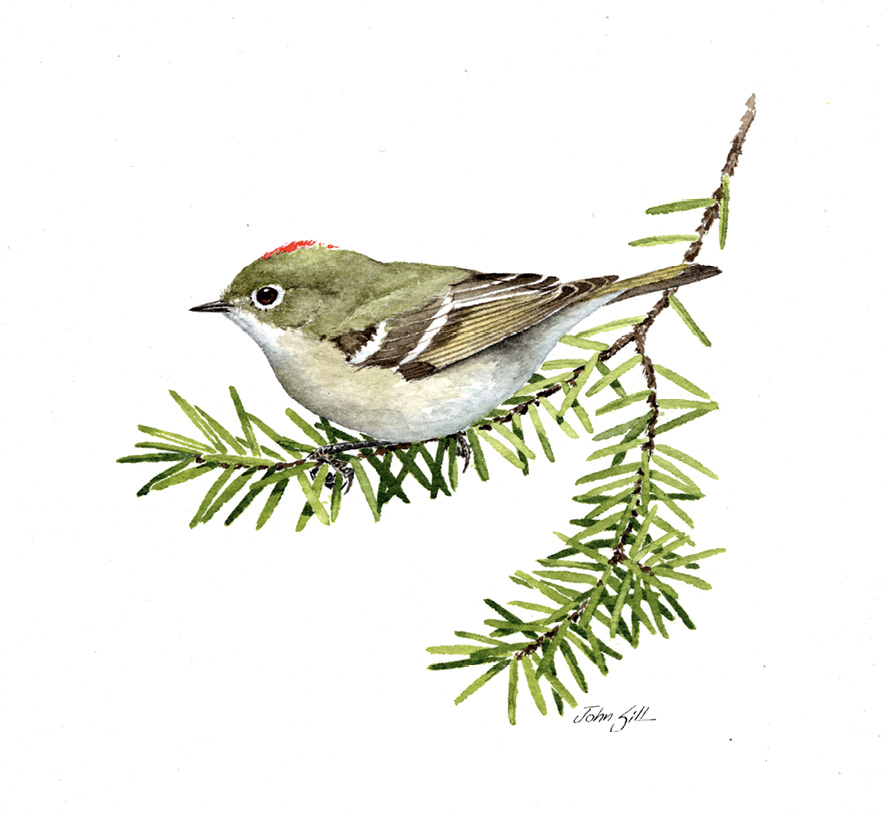Ruby-crowned Kinglet by John Sill

Ruby-crowned Kinglet by John Sill © Massachusetts Audubon Society. Courtesy of the Museum of American Bird Art.
John Sill is a freelance wildlife artist living in the mountains of North Carolina. He was the illustrator for the Bird Identification Calendar for Mass Audubon for many years. His work has appeared in Birds In Art at the Leigh-Yawkey Woodson Art Museum, Wausau, Wisconsin, and in Art of the Animal Kingdom at the Bennington Center for the Arts in Vermont. He continues to illustrate the “About” and “About Habitats” series of natural history books for children written by his wife Cathryn.
Ruby-crowned Kinglet
The Ruby-crowned Kinglet (Corthylio calendula) is one of the tiniest of our songbirds yet produces the largest clutches of any North American passerine species. Ruby-crowned Kinglets are gray-green above and light yellowish gray below. They have two distinct, white wing bars on dark gray wings and a white eye ring that is broken at the top and bottom. The sexes are similar in appearance except for the scarlet crown of the male. They have tiny bills and can often be identified by their almost constant wing-flicking behavior.
The Ruby-crowned Kinglet is easily separated from Golden-crowned Kinglet (Regulus satrapa) by the latter’s boldly striped face and crown. The taxonomy of the genus Regulus is problematic, with studies indicating that the Ruby-crowned and Golden-crowned kinglets have a substantial genetic distance between them, which is usually associated with different genera. Ruby-crowned Kinglets differ from all the other Regulus species as well, leading to classification in its own genus: Corthylio. Three subspecies are recognized. C. c. calendula breeds from Alaska in a broad swath across Canada south of Hudson Bay to Newfoundland that dips into the United States around the Great Lakes region and through northern New England. C. c. grinnelli breeds from coastal Alaska south through British Columbia. C. c. obscurus formerly inhabited Isla Guadalupe, Mexico, and is now extinct.
In the western United States, Ruby-crowned Kinglets breed or are year-round residents in the mountains from Washington State south through central California, Nevada, Arizona, and New Mexico; they also breed from Montana south to New Mexico. Ruby-crowned Kinglets winter from Washington State to the Southwest and continue through Mexico to Guatemala. In the East, they winter sparingly from southern Massachusetts and Connecticut south through Florida and west through Missouri and southern Kansas, Texas, and Mexico. In Massachusetts, there only a few questionable breeding records. However, the Ruby-crowned Kinglet is a common to sometimes abundant migrant but a scarce and irregular winter visitor. Ruby-crowned Kinglets arrive in Massachusetts in early April; fall migration peaks in early October. They frequently join mixed flocks of other small woodland species on their wintering grounds.
Ruby-crowned Kinglets are monogamous. They breed when a year old and produce a single brood each year. Because Ruby-crowned Kinglets usually nest high in spruce trees or other conifers, making observation difficult, little is known of courtship or nest building. The loud, jumbled, musical song is given by the male on the breeding grounds, usually from a high perch in a conifer. An abbreviated version is given by the female. The song has been described as two-parted, the first being a high-pitched tee or zee note followed by a series of tu or turr notes. The second part is composed of loud, high-pitched notes: tee-da-leet, tee-da-leet, tee-da-leet. They also have several contact calls. Males have several aggressive displays that may be related to territorial defense. The most extreme display involves a male leaning forward and down toward an opponent with tail cocked, rump feathers fluffed, white wing bars exposed, and scarlet crown fully erect, as the bird vigorously sings. A toned-down version of this display may play a role in courtship.
In the East, Ruby-crowned Kinglets primarily nest in spruce-fir forests or mixed hardwood-conifer forests, usually close to water. In the West, they tend to nest in coniferous forests. It is thought that the female selects the nest site high in a spruce or other conifer; the nest is suspended from small branches or on a limb, often near the trunk, and always protected by overhanging foliage. The female builds the open, often pendulous cup nest, which is made of moss, lichens, twigs, rootlets, conifer needles, and spider web, and lined with mammal hair, feathers, and fine grasses. The female alone broods the usual clutch of seven to eight eggs—there can be up to 12— for about two weeks until hatching. The eggs are buffy white and spotted with red brown around the large end. At hatching, the chicks are helpless, without a covering of down and with their eyes closed. While the female broods the chicks, the male may bring her food. Both parents feed the chicks. The period to fledging is poorly known; in one instance, it was 16 days. At another nest, a male was observed feeding the chicks 10 days after fledging.
Ruby-crowned Kinglets forage mostly in conifers, usually by gleaning needles, but also by hovering, hawking, and pecking at branches. Their diet consists primarily of insects such as flies and beetles, spiders, and berries and some small seeds in summer. They also visit sapsucker wells for sap and insects.
Ruby-crowned Kinglet adults and young are taken by owls, hawks, and grackles; and their nests are also robbed by jays and squirrels. Many are killed each year in collisions with towers during migration. Logging and wildfires are a constant threat on both the breeding and wintering grounds. Despite these threats, several factors work to their advantage: (1) the breeding range is widespread and often secluded, (2) Partners in Flight estimates a breeding population of 90,000,000 birds, and (3) Breeding Bird Census data indicate a stable population from 1966 through 2015. Thus, it appears that the future of this lovely tiny songbird is secure.
William E. Davis, Jr.